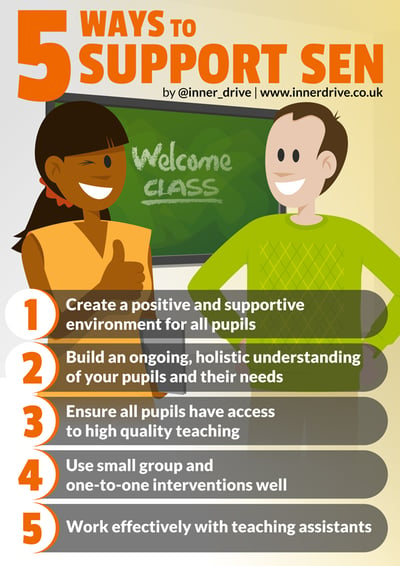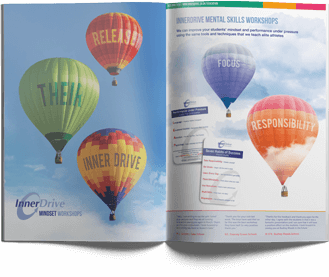At any one time, roughly 15% of students have Special Educational Needs (SEN). That’s nearly 5 students in a classroom of 30. Being able to support children with SEN is becoming a priority for mainstream teachers, not just for special schools.
Research suggests that the greatest influence on educational and social outcomes for children with SEN is their classroom teacher. But without the expertise of those who work in special schools, many mainstream teachers are feeling unequipped and unsure of how best to support the growing number of children with SEN in their classrooms.
Fortunately, the Education Endowment Foundation (EEF) very recently published a report on supporting SEN in mainstream schools (we recommend reading the full report, which you can do by clicking on the link). In it, they give 5 recommendations to follow that can help in both primary and secondary schools. We have briefly summarised these 5 recommendations below…
 1. Create a positive and supportive environment for all pupils, without exception
1. Create a positive and supportive environment for all pupils, without exception
The report explains how the number one priority for schools and teachers should be aiming for inclusivity. This means removing barriers to learning and participation for children who have SEN, providing all students with an education that is in line with their needs, as well as helping all students to achieve their full potential and promoting high standards. This can be done through:
- Encouraging positive relationships, fostering active engagement, and nurturing well-being of all students.
- Ensuring that all students can access the best teaching possible.
- Having a positive and proactive behaviour approach. For example, modelling, reinforcing and rewarding positive behaviours; trying to understand why students misbehave when they do; considering student needs when managing this misbehaviour; and keeping the approach to behaviour regular and consistent.
2. Build an ongoing, holistic understanding of your pupils and their needs
Another key point outlined in the report was the need for teachers and schools to understand each and every individual pupil’s learning needs. The EEF outlines a four-step approach to developing this understanding:
- Assess - create a picture of your student’s needs, gathering information from several sources.
- Plan - using this information, think about the type of support that might work for the student. This should consider research-based teaching strategies as well as any strategies suggested by specialist professionals.
- Do - put that plan into action.
- Review - how did the student respond to the support? Establish whether the support was successful, or whether you should update your understanding of the student’s needs and develop different support.
The report also recommends that to gain true understanding of each pupil, assessment of their needs should follow a regular, organised plan rather than one-off, here-and-there assessments. Teachers and schools will also benefit from looking at the wider picture when seeking to understand their students’ needs. For example, parents, carers, specialist professionals and the pupils themselves can provide valuable input.
Gathering a comprehensive and complete view of a student’s needs in this way can empower teachers to know the best way in which to teach them, and help them see the next steps for moving forward.
Finally, it’s important to remember that children’s needs do change over time. Some students may enter a class with SEN, but no longer have them later on. Others may start without SEN, but develop them as they get older.
3. Ensure all pupils have access to high quality teaching
In many ways, good practice in teaching children with SEN equals good practice in teaching all children. In fact, teachers may be reassured to know that many of the skills needed when working with children who have SEN will be those that they are already developing and using with all their students. As the report puts it, “searching for a ‘magic bullet’ can distract teachers from the powerful strategies they often already possess.”
The advice, therefore, is that there are certain teaching strategies with which many teachers will already be familiar that they can emphasise with SEN students. You can use these strategies with all students, apply them flexibly and adapt them according to the needs of each student. These strategies are:
- Flexible grouping - there can be a tendency to group children with SEN or considered to have low attainment in the same classes. But, this doesn’t account for individual strengths and weaknesses, and can have a negative impact on learning, so should be avoided.
- Cognitive + metacognitive strategies - teaching students to better understand their own thinking and learning processes.
- Explicit instruction - a teaching approach that involves teacher demonstration, followed by guided practice for worked exercises, and eventually independent work. Rosenshine’s Principles of Instruction are a great example of this.
- Using technology - such as apps which help to develop reading, writing and communication skills.
- Scaffolding - supporting students on tasks and gradually removing this support until they can complete the task independently.
4. Complement high quality teaching with carefully selected small group and one-to-one interventions
High quality teaching, as we’ve just discussed, is paramount, but it is not everything. Some students with SEN will also need extra high-quality support, in small groups or one-to-one. As with the assessment of students’ needs, extra support by way of small group/one-to-one interventions should be well-structured, carefully implemented, and tailored to individual needs. In fact, if teachers are able to develop a thorough understanding of their students’ needs, as in recommendation 2, it can inform them as to the kind of targeted small group support students need. For example, the report explains that the required intensity of the intervention will depend on the level of each student’s needs:
- Low need - universal intervention
- Medium need - targeted intervention
- High need - specialist intervention
5. Work effectively with teaching assistants
The final recommendation set out by the EEF report is that teachers should work effectively with teaching assistants (TAs). TAs are as essential to supporting students and their learning as classroom teachers, and the report sets out that teachers should be sure to pay attention to the roles of TAs and the positive impact they can have on children with SEN. Here are some examples of more tips from the EEF for making good use of TAs:
- TAs should add value to the work of the classroom teacher rather than replace it.
- TAs should not simply be used for informal teaching for low-achieving students.
- TAs should help students develop independent learning skills.
- TAs need to be well prepared for their role in the classroom.
- TAs can be used to lead high-quality small group/one-to-one intervention (recommendation 4).
FINAL THOUGHTS
We hope you’ve found this summary useful, but we do encourage you to read the full EEF report. And don’t forget, the evidence shows that there is no ‘golden nugget’ of information to seek.
In fact, one of the best things teachers can do to support the learning and achievement of their students with SEN, is to emphasise those powerful teaching strategies with which they may already be familiar, such as scaffolding and metacognition.







